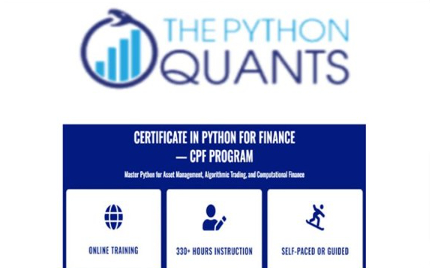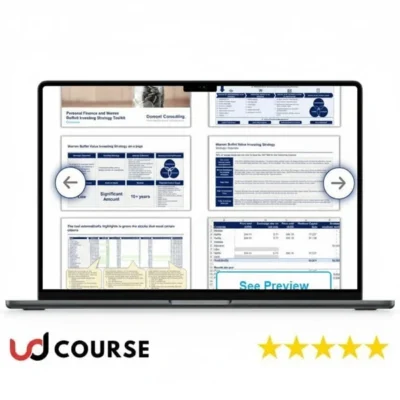
The Python Quants – CPF PROGRAM

CPF PROGRAM Course: Master Python for Quantitative Finance with The Python Quants
In today’s fast-paced financial landscape, mastering programming and quantitative analysis is essential for professionals and students alike.
The CPF PROGRAM course by The Python Quants offers a unique opportunity to gain cutting-edge skills in Python programming tailored specifically for the world of finance.
Designed by Dr. Yves J. Hilpisch, a renowned expert in Python for finance, this program equips participants with the knowledge and tools needed to excel in quantitative finance, algorithmic trading, and financial data analysis.
Whether you’re a seasoned finance professional looking to enhance your analytical capabilities or an aspiring quant, the CPF PROGRAM course offers the perfect blend of theory and practical application to elevate your career.
Why Is the CPF PROGRAM Course by The Python Quants a Must for Finance Professionals?
The CPF PROGRAM course provides a comprehensive education in Python for finance, making it indispensable for professionals seeking to stay competitive in today’s data-driven markets.
Unlike generic programming courses, this The Python Quants course focuses specifically on the financial industry, covering essential Python libraries like NumPy, pandas, and scikit-learn. These libraries are widely used for financial modeling, data analysis, and algorithmic trading.
Python has become the go-to programming language for quantitative finance because of its versatility and the powerful libraries that support complex financial computations.
The CPF PROGRAM course is tailored for participants who want to harness Python’s power to analyze financial data, build models, and automate trading strategies.
By completing this course, you’ll be confident to apply Python in real-world financial scenarios, giving you a competitive edge in the finance industry.
How Does the CPF PROGRAM Course Teach Python for Finance?
The CPF PROGRAM course begins by providing a solid foundation in Python programming, with a focus on concepts and libraries specifically relevant to finance. Python is known for its simplicity and flexibility, making it an ideal language for financial analysis and modelling.
Learning Python for Financial Applications
In this The Python Quants course, you’ll start with Python programming basics and quickly advance to more complex financial applications. The curriculum includes in-depth coverage of core Python libraries such as:
- NumPy for numerical computing and handling large datasets,
- pandas for data manipulation and analysis,
- matplotlib for creating financial visualizations,
- scikit-learn for applying machine learning techniques to financial data.
Building Essential Programming Skills for Finance
Participants will learn how to write Python code that solves common financial problems, including portfolio optimization, risk management, and option pricing.
By the end of the CPF PROGRAM course, you’ll be comfortable with Python’s syntax, data structures, and libraries and can apply these skills to quantitative finance projects.
What Quantitative Finance Concepts Are Covered in the CPF PROGRAM Course?
The CPF PROGRAM course goes beyond programming to teach the essential concepts of quantitative finance.
Understanding the mathematics and financial theories behind quantitative analysis is just as important as learning how to code.
This The Python Quants course covers a range of quantitative finance topics that are crucial for success in the field.
Understanding Fundamental Financial Theories
Participants will delve into critical areas such as the time value of money, portfolio theory, option pricing models, and risk management.
You’ll learn how these concepts are applied in practice, and you’ll see how Python can be used to model and solve financial problems. Topics like Black-Scholes pricing, Monte Carlo simulations, and portfolio optimization are also covered, providing a robust framework for understanding quantitative finance.
Practical Application of Financial Models
You’ll gain hands-on experience in applying these theories to real-world financial scenarios through coding exercises and case studies.
This CPF PROGRAM course emphasizes the practical application of quantitative finance concepts, allowing participants to move beyond theory and develop the skills needed to tackle real financial challenges.
How Does the CPF PROGRAM Course Approach Financial Data Analysis?
Financial data is the lifeblood of quantitative finance, and being able to work effectively with data is critical to making informed decisions.
The CPF PROGRAM course by The Python Quants teaches participants how to acquire, clean, and analyze financial data using Python. This includes techniques for working with time series data, performing statistical analysis, and visualizing financial trends.
Acquiring and Cleaning Financial Data
Participants in the CPF PROGRAM course will learn how to source financial data from various platforms and APIs, and how to clean and preprocess this data for analysis. Data cleaning is an essential step in financial modeling, as real-world data often contains inconsistencies, missing values, and other issues that can affect analysis.
This The Python Quants course ensures that participants have the skills to handle data confidently and prepare it for analysis.
Analyzing and Visualizing Financial Data
Using Python libraries like pandas and matplotlib, you’ll be able to visualize financial data to identify trends, correlations, and anomalies. This is critical for making data-driven decisions in finance.
You’ll also learn how to perform statistical analysis on financial datasets, including calculating returns, volatility, and risk metrics. By the end of the CPF PROGRAM course, you’ll be equipped to use Python for in-depth financial data analysis and visualization, enabling you to make more informed investment decisions.
How Does the CPF PROGRAM Course Teach Algorithmic Trading?
Algorithmic trading is a key focus of the CPF PROGRAM course, and participants will learn how to design, backtest, and implement automated trading strategies using Python. The course covers a range of algorithmic trading concepts, from basic rule-based systems to more complex strategies that incorporate machine learning.
Designing and Backtesting Trading Algorithms
Participants will learn how to build trading algorithms using Python and libraries like Pandas and Backtrader.
The CPF PROGRAM course emphasizes the importance of backtesting—testing your trading strategies on historical data to evaluate their performance before deploying them in live markets.
You’ll gain hands-on experience in designing and refining trading algorithms and learning how to optimize strategies based on backtest results.
Exploring Automated Investment Strategies
The Python Quants course will teach you about automated investment strategies, including momentum trading, mean reversion, and market-making.
The course covers topics like market microstructure and order execution, ensuring that you deeply understand how algorithmic trading works in practice.
By the end of the course, you’ll have the skills to implement your own automated trading strategies and optimize them for different market conditions.
How Does the CPF PROGRAM Course Combine Theory with Hands-On Projects?
One of the most valuable aspects of the CPF PROGRAM course is its emphasis on hands-on learning. Participants work on capstone projects and case studies that simulate real-world financial scenarios, allowing them to apply the skills they’ve learned throughout the course.
This project-based approach helps participants build confidence in their abilities and prepares them for real-world applications of Python in finance.
Working on Real-World Financial Scenarios
Throughout the course, you’ll engage in projects that mimic the challenges faced by quants and financial analysts in the field. These projects range from building trading algorithms to creating financial models and analyzing large datasets.
Each project is designed to reinforce the concepts and skills taught in the CPF PROGRAM course, allowing you to demonstrate your proficiency in Python for finance.
Demonstrating Proficiency with Capstone Projects
Capstone projects are a key component of the CPF PROGRAM course, allowing participants to showcase their mastery of the subject. These projects challenge participants to apply everything they’ve learned—from Python programming to quantitative finance concepts and algorithmic trading—culminating in comprehensively demonstrating their skills.
Upon completing the course and successfully passing the final examination, participants will receive a Certificate in Python for Finance (CPF), attesting to their expertise.
How Does the CPF PROGRAM Course Foster Interactive Learning?
The CPF PROGRAM course by The Python Quants offers an interactive and dynamic learning environment.
Participants can access an online platform to engage with instructors, collaborate with peers, and work through coding exercises, quizzes, and discussions.
This interactive format encourages participants to ask questions, share insights, and deepen their understanding of the material.
Engaging with Instructors and Peers
In this The Python Quants course, you’ll have the opportunity to engage directly with Dr. Yves J. Hilpisch and other experts in the field. This access to experienced instructors ensures that you get personalized guidance throughout the course.
Collaboration with peers also enhances the learning experience, as you can share knowledge and work through challenges together.
Accessing Comprehensive Learning Resources
The CPF PROGRAM course offers a wealth of resources, including lectures, coding exercises, and detailed course materials. Participants can access these resources at any time, allowing for flexible learning that fits around their schedules.
The course provides the tools you need to succeed, whether you prefer to learn at your own pace or engage in live discussions.
Conclusion: Why the CPF PROGRAM Course Is Essential for Aspiring Quants
The The Python Quants – CPF PROGRAM is an essential course for anyone looking to build a career in quantitative finance. With its comprehensive curriculum, hands-on projects, and certification, this course equips participants with the knowledge and skills needed to excel in finance using Python.
Whether you’re a finance professional seeking to enhance your analytical capabilities or a student aspiring to enter the world of quantitative finance, the CPF PROGRAM course offers a structured and practical learning experience that will set you apart in the competitive finance industry.
Enroll today and take the next step toward mastering Python for finance!




